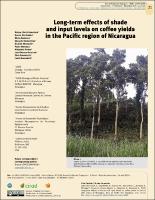Long-term effects of shade and input levels on coffee yields in the Pacific region of Nicaragua
ISSN
L-0006-579XDate
2020Author
López-Sampson, Arlene
Sepúlveda, Norvin
Barrios, Mirna
Somarriba, Eduardo
Munguía, Rodolfo
Moraga, Pedro
Ponce, Alejandro
Orozco-Aguilar, Luis
Navarrete, Elvin
Navarrete, Ledis
Type
Artículo
Metadata
Show full item recordAbstract
The suitability and profitability of coffee cultivation in Central America are at risk due to pest and disease outbreaks, price fluctuations and climate change. Proper shading is claimed to be one of the most promising practices to seek sustainability and better adapt coffee cultivation to climate change in marginal areas. This study recorded and compared coffee cherry yields over a ten-year period from shaded coffee (N-fixing-trees and timber trees) agroforestry systems under different management regimes (conventional vs. organic) in a suboptimal site. Significant differences in production were detected between conventional inputs vs. combination of organic inputs and shade types in some years of the evaluation period. Full-sun cultivation under intensive management was the most productive system for coffee yields, followed by shaded systems under timber trees. Interestingly, and regardless of management systems (intensive conventional or intensive organic) the worst combinations in terms of coffee yield were shaded systems under leguminous species (Inga laurina (Sw.) Willd. + Simarouba glauca DC.). Across all experimental plots, the timber species Simarouba glauca and Tabebuia rosea (Bertol.) DC. grew well, reaching a mean annual increment in diameter of 2.5-3.3 cm/year (age 12 years). Average gross revenues were higher in full-sun and timber-shaded agroforestry systems. Overall, intensive management regimes were the most expensive cultivation system to run but also the best in terms of coffee yield performance.
Keywords
Publisher
CIRAD, Montpellier (France)
Is part of
Bois et Forêts des Tropiques


